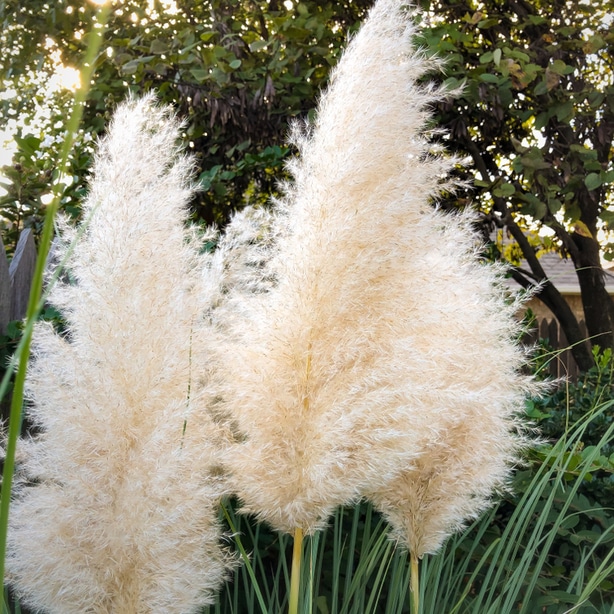A striking perennial ornamental grass with feathery white plumes is hard to resist, and this one is a giant. At its mature size of up to 12 feet tall and 6 feet wide, it can be almost intimidating.
But it has a lot to offer. Where other grasses give way to shrubs and trees, pampas grass, Cortaderia selloana, holds its own as a landscape specimen, foundation plant, or living screen. The slightest breeze causes its foliage to rustle and sway, subtly adding motion and sound to the garden. With a minimal amount of care and maintenance, it will thrive season after season.
Make sure to also check out our guide on proper techniques to trim your arborvitae. Keeping your trees on your property healthy are just as important as the ornamental grasses that you grow.

Growing Pampas Grass
This grassland native of South America has been planted in mild climates worldwide, from the United States to New Zealand and beyond. It grows best in full sun exposure and well-drained soil. It’s a tough plant that forms dense clumps of long, arching foliage.
The eight-foot-long grass blades have surprisingly sharp edges capable of cutting skin. In late summer, the plant sends up thick, straight flower stalks that end in huge white plumes, sometimes tinged in pink. The flowers on female plants are fuller and more impressive than those on male plants.
A heat-loving grass, pampas is at home in USDA hardiness zones 7 through 11, where it is mostly evergreen. It is marginally hardy in zone 6, where the foliage dies back each winter. In cool zones, plant it in a sheltered spot where it will receive early and midday winter sunshine, and receive protection from prevailing winds.

Planting for Success
At the plant store, you’ll find the species along with different named cultivars of pampas grass plants. Cultivars feature improvements such as compact growth habit, variegated foliage, intense bloom color, or better cold tolerance. Choose the one that best suits your location and aesthetic. The appearances may differ, but growing conditions are the same.
Dig the hole twice as wide as the container that the plant is growing in and about the same depth. Mix the soil that came from the hole with compost at a one-to-one ratio. Carefully remove the plant from the container, and gently loosen any tightly bound roots. Place the plant in the prepared hole, and make sure the soil surface of the root mass is slightly higher than the surrounding soil. Backfill the hole with the soil mixture. Press firmly on the soil to remove air pockets, then water deeply. Finally, cover the root zone with a two to three-inch layer of mulch.
Watering and Fertilization
This plant takes moisture extremes in stride. In its native environment, pampas grass survives flooding part of the year and severe, extended drought at other times. Once established, they are very drought tolerant.
Water new plants regularly during the first growing season to promote a deep root system. In later years, irrigate with one inch of water per week when there is no rainfall to avoid brown leaf tips.
Pampas grass has no special plant food requirements but will happily thrive on residual nutrients leftover from a nearby lawn. Maintain a two to three-inch layer of organic mulch, such as wood chips, compost, or pine needles, and fertilize once per year with a balanced slow-release fertilizer.

Make sure to also check out our guide on how to raise healthy buffalo grass.
Ongoing Maintenance
Although it may seem like a hands-off plant, some routine maintenance is necessary to keep it looking good and in good health. In late winter or early spring each year, prune the foliage back just above ground level. Be sure to protect yourself with long sleeves, gloves, and safety glasses for this project. Bundle the foliage together with twine, and use power hedge shears or a chainsaw to cut it off 10 to 12 inches above the ground.
After three or four growing seasons, the plant will have become quite large. So large, in fact, that you may notice while cutting it back that the interior is becoming hollow. The outside roots continue to grow outward, but the interior root crown is dying from a lack of sunlight. This is a good time to dig up the entire plant. Use a sharp garden spade to cut away the good parts into about four healthy divisions. Then remove the dead portion of the crown. Replace the original with one of the divisions. Plant the others elsewhere, share them with friends, or compost them.

When It Becomes a Weed
Unfortunately, it’s not all softly swaying grass and pretty plumage. In some areas around the world, pampas grass has escaped cultivation to become a wild nuisance. In these places, it can out-compete native grasses without supplying local wildlife with the resources they need. In this case, it must be treated as an invasive weed. The simplest way to deal with it is to dig it out.
In much of the world, pampas grass simply thrives as a larger than life ornamental grass. It serves various purposes and looks great with just a small amount of routine care and maintenance.



They are my favorite grasses to grow with hugh plumes but they don’t survive the Massachusetts winters with all that cold & snow